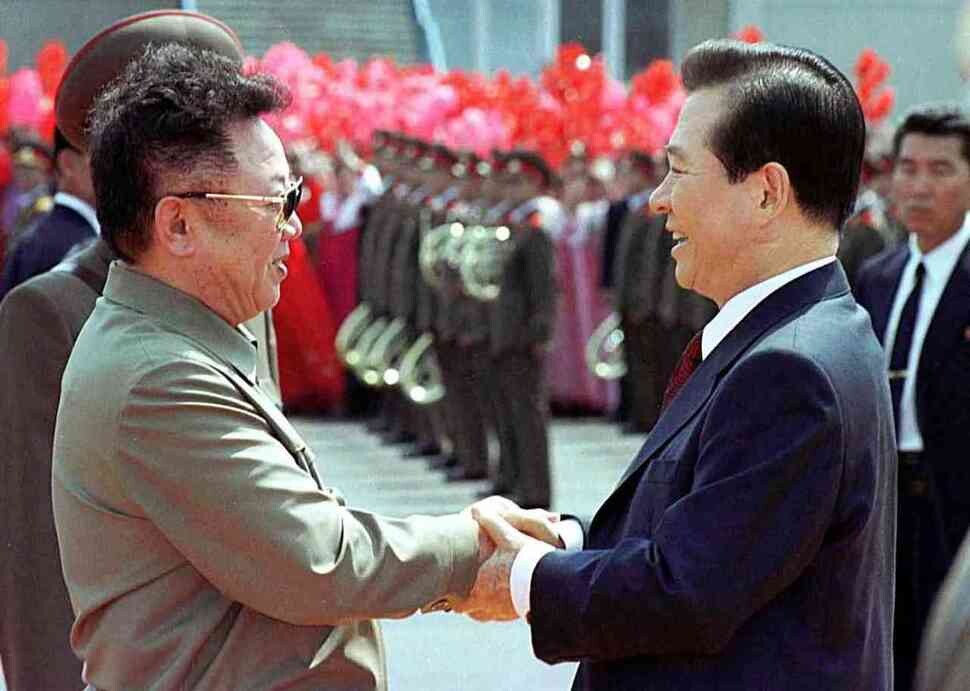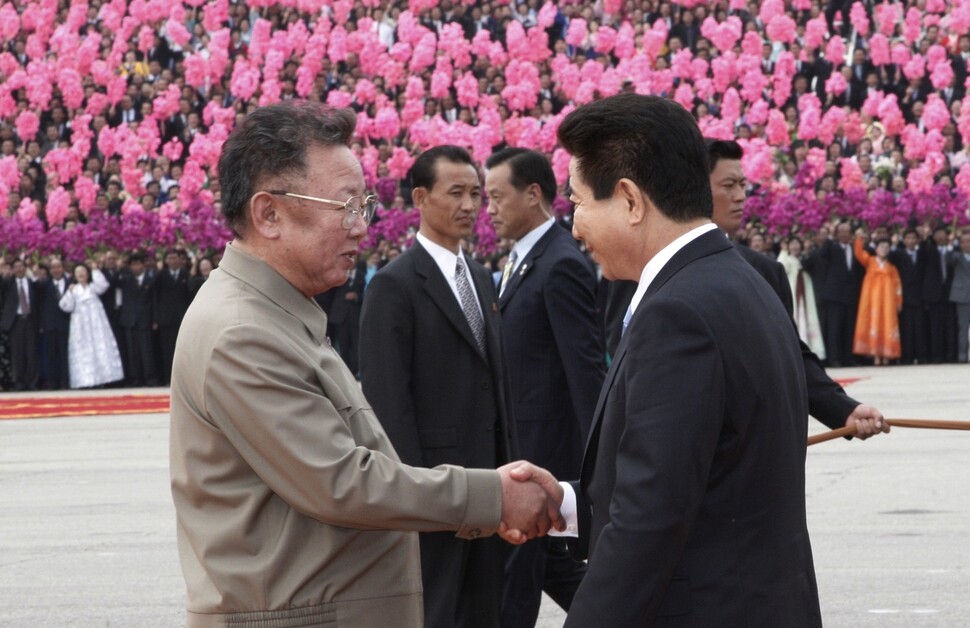hankyoreh
Links to other country sites 다른 나라 사이트 링크
Past experience can aid Moon administration in weighing options for third inter-Korean summit
North Korean Workers' Party Chairman Kim Jong-un's invitation for President Moon Jae-in to visit the North raises the possibility of a third summit meeting. President Moon has even mentioned "conditions" for such a summit, but when a meeting of the two leaders might take place remains an unknown. Considering the fact that the first two summits were held in spite of such problems as the launch of Taepodong-1 and the North's first nuclear test, it is worth taking another look at those intense negotiations that were conducted in secret at the time between South Korea and North Korea and between the United States and the two Koreas.

First summit took place in June 2000
The first summit, held on June 15, 2000, between President Kim Dae-jung and Chairman Kim Jong-il, is regarded as the result of outstanding political and diplomatic efforts. In his inaugural address of February 1998, President Kim expressed his readiness for a summit meeting and suggested an exchange of special envoys and a policy of engagement toward North Korea. President Kim continued to make such proposals concerning the North, but the political climate quickly cooled in August that year after the US Defense Intelligence Agency (DIA) raised suspicions that North Korea had detonated a nuclear device underground at Geumchang-ri and conducted a test launch of its Taepodong-1 missile in North Hamgyong Province on August 31.
Pushed by conservative hard-liners, U.S. President Bill Clinton appointed William Perry to lead a North Korea Policy Review. Perry had previously been Secretary of Defense and had considered bombing the North's Yongbyon nuclear facility. The South Korean government worked to dissuade him from upsetting its Sunshine Policy. Lim Dong-won, who was the senior secretary to the president for foreign affairs and national security at the time, met with Perry in January and March of 1999 and exchanged ideas about a comprehensive approach to North Korea.
This collaborative effort to solve the problem of the North's missile program and adjust US relations with Pyongyang was a tripartite project of consultations between South Korea, the United States, and Japan, dubbed the "Perry Process." It led to Perry's first visit to North Korea in May of that year. The South-North and US-NK talks brought about the announcement of a moratorium on missile tests and an easing of U.S. sanctions on North Korea. South Korean government officials had been very busy traveling back and forth between the U.S., the North, China, and Japan to bring about a consensus that would lead to this achievement.
As North Korea's relations with the US improved, inter-Korean relations also kept pace. Then-Minister of Culture and Tourism Park Jie-won played a lead role in three closed-door talks with Song Ho-kyung, the vice chairman of North Korea's Asia-Pacific Peace Committee on Mar. 17, 2000, which resulted in an Apr. 10 joint announcement that a summit meeting would be held on June 15.
As a result of that summit, Jo Myong-rok, director of North Korea's General Political Bureau, visited Washington in October 2000 and a U.S.-DPRK Joint Communiqué was issued. After U.S. Secretary of State Madeleine Albright's visit to Pyongyang that October, it was predicted that North Korea and the U.S. might be able to establish normal diplomatic relations. The warming of Washington's relations with Pyongyang was short-lived, however, ending with the election of Republican George W. Bush in November.

Second inter-Korean summit between Roh Moo-hyun and Kim Jong-il
The second South-North summit, held on Oct. 3, 2007, between President Roh Moo-hyun and Kim Jong-il, found some hints of resolution in relations as the Bush administration took a step back from its confrontational stance that labeled North Korea as part of the "Axis of Evil" and an "outpost of tyranny." Roh had been elected at the end of 2002, at a time when tensions were high over the so-called "second North Korea crisis" because of Pyongyang's highly enriched uranium (HEU) program.
The Six Party Talks, aimed at solving the problem of North Korea's nuclear program, began in Beijing in 2003. In the fourth round of talks, in 2005, the participants issued an agreement on a joint statement. In June of that year, the Roh administration had sent then Unification Minister Chung Dong-young to propose that the South would provide two million kilowatts of electricity and other aid, which could play a role in getting Pyongyang back to the negotiating table at the Six Party Talks. However, the day after the joint communiqué was issued, the United States accused North Korea of being guilty of money laundering and announced sanctions against Macau's Banco Delta Asia (BDA), to which North Korea responded by conducting its first successful nuclear test on Oct. 9, 2006.
In the face of Pyongyang's brinkmanship, South Korea and the United States held bilateral talks to discuss overall strategies to get North Korea back into the Six Party Talks, including lifting sanction on BDA and halting the North's nuclear tests. Before the Six Party Talks resumed, however, the U.S. declared that it would not ease the sanctions on North Korean assets in BDA, and North Korea said it would refuse to return to negotiations unless the sanctions were lifted. Stuck in the middle, the South Korean government persuaded the Bush administration to reconsider. Finally, in the fifth round of Six Party Talks in 2007, North Korean and U.S. delegates sat face-to-face again, and on Feb. 13 a joint statement was issued whereby the Yongbyon nuclear facility would be shut down and sealed off.
From this point, the Roh administration pushed ahead with its efforts to hold a second inter-Korean summit. In early July, Kim Man-bok, then director of the National Intelligence Service, suggested to Kim Yang-gon, the North Korean official in charge of South Korean affairs, that they have contact. He was sent to visit the North in secret as a special emissary twice in August of that year.
Moon Jae-in, who Roh’s chief presidential secretary at the time, headed the committee that would oversee the second summit meeting. On Oct. 4, a declaration was issued promoting better relations between the South and the North, with a goal of ending the armistice and achieving permanent peace on the Peninsula. However, with the election of the Grand National Party's Lee Myung-bak to the presidency in December that year, progress toward the goals of the summit were halted.
The South Korean government played the important role of intermediary messenger between North Korea and the United States in the first and second summit meetings. When South Korea and the U.S worked together, the South Korean government was able to achieve improvements in South-North relations and to get relations between Pyongyang and Washington on a better footing as well. The experience gained through this history can serve the Moon Jae-in administration well in its efforts to create the right conditions for a third summit.
By Kim Ji-eun and Noh Ji-won, staff reporters
Please direct questions or comments to [english@hani.co.kr]

Editorial・opinion
![[Column] Season 2 of special prosecutor probe may be coming to Korea soon [Column] Season 2 of special prosecutor probe may be coming to Korea soon](https://flexible.img.hani.co.kr/flexible/normal/500/300/imgdb/original/2024/0426/3317141030699447.jpg) [Column] Season 2 of special prosecutor probe may be coming to Korea soon
[Column] Season 2 of special prosecutor probe may be coming to Korea soon![[Column] Park Geun-hye déjà vu in Yoon Suk-yeol [Column] Park Geun-hye déjà vu in Yoon Suk-yeol](https://flexible.img.hani.co.kr/flexible/normal/500/300/imgdb/original/2024/0424/651713945113788.jpg) [Column] Park Geun-hye déjà vu in Yoon Suk-yeol
[Column] Park Geun-hye déjà vu in Yoon Suk-yeol- [Editorial] New weight of N. Korea’s nuclear threats makes dialogue all the more urgent
- [Guest essay] The real reason Korea’s new right wants to dub Rhee a founding father
- [Column] ‘Choson’: Is it time we start referring to N. Korea in its own terms?
- [Editorial] Japan’s rewriting of history with Korea has gone too far
- [Column] The president’s questionable capacity for dialogue
- [Column] Are chaebol firms just pizza pies for families to divvy up as they please?
- [Column] Has Korea, too, crossed the Rubicon on China?
- [Correspondent’s column] In Japan’s alliance with US, echoes of its past alliances with UK
Most viewed articles
- 1[Column] Season 2 of special prosecutor probe may be coming to Korea soon
- 2‘We must say no’: Seoul defense chief on Korean, USFK involvement in hypothetical Taiwan crisis
- 3Division commander ordered troops to enter raging flood waters before Marine died, survivor says
- 4Is N. Korea threatening to test nukes in response to possible new US-led sanctions body?
- 5Is Japan about to snatch control of Line messenger from Korea’s Naver?
- 6No good, very bad game for Korea puts it out of Olympics for first time since 1988
- 7[Editorial] Korea’s surprise Q1 growth requires objective assessment, not blind fanfare
- 8Korea’s 1.3% growth in Q1 signals ‘textbook’ return to growth, says government
- 9N. Korean delegation’s trip to Iran shows how Pyongyang is leveraging ties with Moscow
- 10Amnesty notes ‘erosion’ of freedom of expression in Korea in annual human rights report